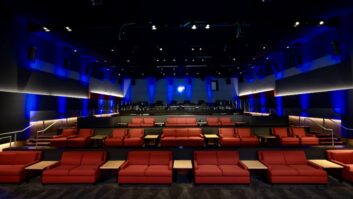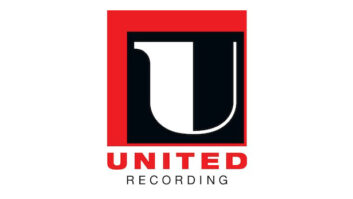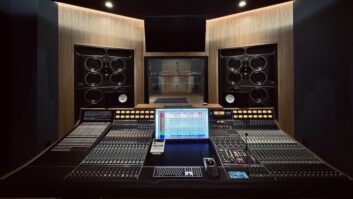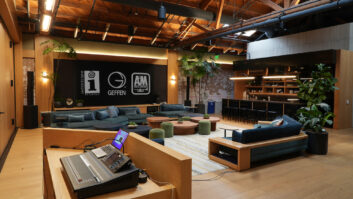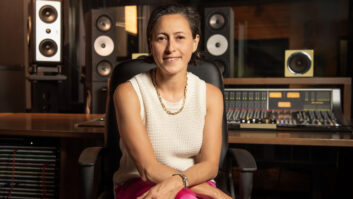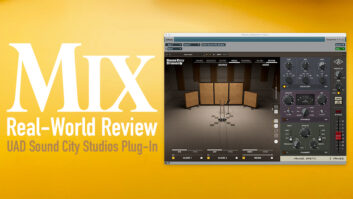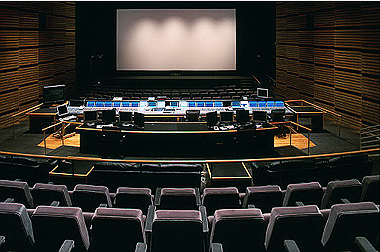
photo: Gary Krueger
When Universal Studios opened Blu Wave Audio — a digital transfer, mastering and restoration facility — on the lot in 2003, it was immediately seen as a smart move. Consumers were demanding DVDs; Universal had the catalog. Technical filmmaking had changed; facilities had to deal with new formats. Budgets were shrinking; studios needed to find new workflow efficiencies. In reality, Blu Wave was simply the first public glimpse at a five-year plan to revamp the entire sound services department.
Today, with the redesign or new construction of three feature film mixing stages, four TV stages, 54 brand-new 5.1 editorial rooms, a trailer mixing room and enlarged client areas, the five-year plan is all but complete. And Universal stands at the forefront of Hollywood’s return to lot-based sound services.

Jeff Taylor
“When I arrived here in 2001, Doc Goldstein, Jeff Taylor and I made a five-year plan,” recalls Chris Jenkins, an Academy Award — winning mixer and senior VP of operations at Universal Studios. “We took it to the president and general manager, Jim Watters, and said that this is where we’d like to be in five years. Essentially, we needed to diversify into some of the non-seasonal business and more of the emerging businesses. And we felt the need to eliminate some of the fragmentation and be responsible for anything that has to do with sound on the lot.”
While the streamlined, modern appeal of Blu Wave, the Harrison and Digidesign ICON consoles, and Gigabit Ethernet connectivity have created new synergies and generated a lot of appeal, when chief engineer Goldstein (now VP post-production engineering) moved over from Warner Hollywood, it was not a pretty picture.
“When I came here, the consoles still had tubes in them,” Goldstein says with a laugh. “The Quad Eight consoles in the big rooms had 40 faders, room acoustics were all wrong, we were recording to mag machines with no erase heads and recordists didn’t know how to align their own machines. The TV show Airwolf was in Dubbing Room 1 with a console built by RCA in 1954, with Langevin EQs and Gliss faders. Next door in Dubbing 2, we had an RCA from 1953 with 16 rotary pots. No kidding.”
Along with Bill Varney, Goldstein and crew then set out on an ambitious plan to redo sound services. Dubbing Rooms 1 and 2 came down — one Quad Eight was rebuilt and moved in, the other got a Harrison PP1 — and transfer was remodeled. The TV rooms got similar upgrades, but perhaps the most important move was the beginning of a relationship with architect/acoustician Jeff Cooper, who redid every sound room on the lot. It’s a relationship that continues to this day.

Chris Jenkins
Cooper did not, in fact, design The Alfred Hitchcock Theatre, built originally in the late 1970s and pictured on this month’s cover. However, in 1987, he was brought in to redo the acoustics, followed by some tweaks and mods in the ’90s. His signature is all over the room, which is considered one of the world’s best-sounding mix stages.
The centerpiece of the Hitchcock Theatre is the three-position, 640-input Harrison MPC4-D with TFT metering and direct connectivity to numerous workstation bays on the stage itself. “Harrison came to us in 2003 and said they had their digital platform ready,” Jenkins recalls. “So we purchased one MPC3-D and then looked at each other and said, ‘We have to buy three.’ [Laughter] If capital got cut off and we had one room with the newest MPC and the other two were old analog rooms, then you have status issues, morale issues, technical issues and perception issues with the client.
“We went back to Bill Owen [of Harrison] and worked out a way we could buy three.” The other two reside in Dubbing Rooms 3 and 6 (also newly redone by Cooper, with built-in, side-wing workstation bays) for the mix teams of Andy Koyama/Chris Carpenter and Gregg Landaker/Peter Reale.
By all accounts, Harrison was solicitous in finding out what re-recording mixers most desired in a console. Then the company built the features in. “We talked about what we like in terms of filter sets, the features of the Neve, the tools and toys, and the plug-ins with Pro Tools,” Jenkins says. “Then I went and mixed on a Euphonix and talked to Jeff about how great the heads-up display is. Then I went to NAB and they had it — and then some! It’s got the best of the Euphonix, the best of the Neve and the best of the Harrison. Plus, it looks like a Harrison, so all of our guys can sit down and get to work right away.”

Doc Goldstein
Behind the screen is the JBL Cinema 5000 Series, with Bryston 4BST amplification and Turbosound subs, a combination that Goldstein has pushed throughout the facility, moving down to the 3000 Series for the edit suites. On the day Mix visited, Jenkins and his re-recording partner, Frank Montano, were finaling director Cameron Crowe’s Elizabethtown, due for release in October.
Because the acoustics were all done by Cooper, translation up and down the line — from editorial to premix to final, then back to TV versions — is spot-on accurate, a point Jenkins, Goldstein and crew deemed absolutely necessary in today’s tight post-production schedules. Likewise, because of the Gigabit Ethernet (point-to-point, 10-gig interconnect) connections and 24 terabytes of central storage, automation data and audio files can be pulled up for any project in any room. All Pro Tools editorial systems hang on the network, which can be accessed from any of the stages, including those at Blu Wave.
“We haven’t gotten to the point that we’re sharing recorder/playback technology between the rooms,” says chief engineer Jeff Taylor. “That is more of a centralized topology like Blu Wave. Because we’re working in existing infrastructure, especially in feature dubbing, we have isolated machine rooms that are islands unto themselves. But they’re all connected to our Windows 2003 server families that are managed locally within the sound department.”
Those machine rooms have gotten smaller, but not by much. While Tascam MMPs have replaced mag (and will soon be replaced by whatever company puts out a next-gen playback/recorder combo), a facility such as Universal, because of its vast investment in preservation and restoration, must be able to handle any and all formats, including 24-track and, yes, mag film, as they did on the restoration of E.T. Still, the machine rooms have been cleaned up; the team has installed computer flooring to get rid of overhead cabling. Quite simply, there’s just not as much to wire: The Harrisons are all MADI interconnectivity and Pro Tools wires easily, according to Goldstein.

One of the 54 Jeff Cooper-designed Pro Tools (JBL Cinema 3000 Series speakers) edit suites on the Universal lot.
photo: Gary Krueger
So many shakeups have happened in feature film mixing during the past five years — from shrinking budgets, mass consolidation and loss-leading competition — that the Universal makeover can almost be viewed as a sign of stability and a return to regular cycles. The studio is booked solid in television and feature film through the end of the year, and with the recent purchase by NBC (and preliminary talks on a purchase of Dreamworks SKG), there’s no sign that the pipeline will trickle away anytime soon.
“It’s become much more competitive, and there’s a big tendency toward an erosion of rates by certain parties around town that have had a huge impact on the perception that you can get quality for cheap,” Jenkins says. “We don’t have our eyes closed to it, but we don’t believe in that mentality. We’re fortunate that at this point in time, we can equip well, staff well, pay well and keep the top talent, because that way, we can keep the jobs. We still believe that it’s worth paying a premium price for premium-quality services. That’s why we try to stay small enough; we didn’t build nine feature stages and nine TV stages. We split our business out so that if features are off, digital mastering can help pick it up; if episodic is down, sitcoms can have a big year. So we’re trying to interweave all these businesses.”
It might seem odd that Jenkins refers to Universal as “small,” but once you look past the large rooms and big consoles, there are pockets of productivity everywhere. On the lot are six ProControl rooms, two Digidesign ICON rooms, two more Harrison Series Twelve boards — not to mention the Foley, ADR and trailer mixing services. For Jenkins, it’s about covering the spectrum and being nimble within a large framework. But it’s also about keeping the talent happy — and in-house.
“The most important aspect of it all is that we have really put an emphasis on people, people, people,” Jenkins says. “We value the machine room guy equal to the mixer. Their concerns and the situation we create for them is no less than what we create for Gregg Landaker or Frankie Montano. We value the clients, and we value the talent base extraordinarily.
“Our president and general manager, Jim Watters, once ran editorial here, then post-production,” he continues. “Our success is dependent on Jim’s support and [CEO] Ron Meyers’ philosophy of how a studio should be run and how it should look. We have the two best people to work for in the world.”
Tom Kenny is the editor of Mix
